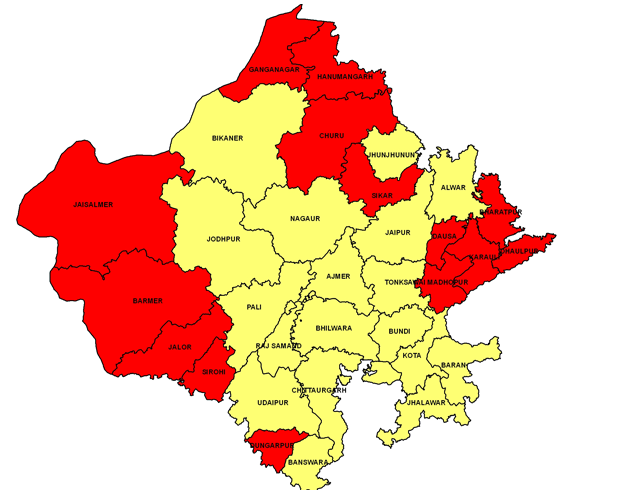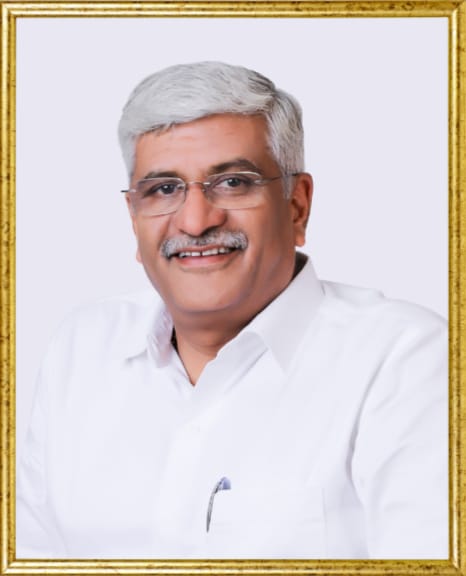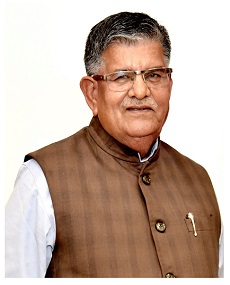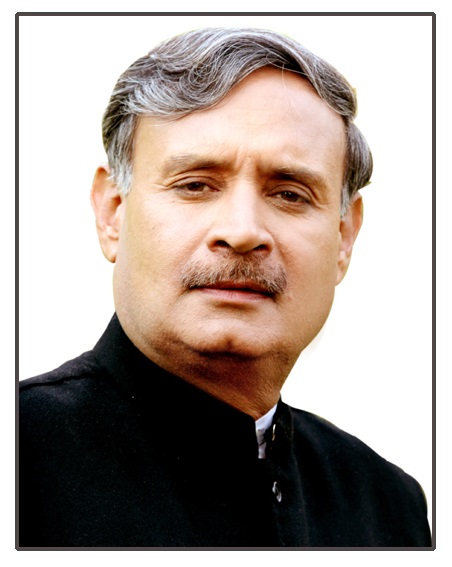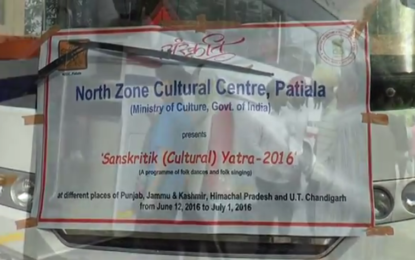RAJASTHAN
Rajasthan, state of India, located in the northwestern part of the subcontinent. It is bounded to the north and northeast by the states of Punjab and Haryana, to the east and southeast by the states of Uttar Pradesh and Madhya Pradesh, to the southwest by the state of Gujarat, and to the west and northwest by Pakistan. The capital city is Jaipur, in the east-central part of the state.
Rajasthan, meaning “The Abode of the Rajas,” was formerly called Rajputana, “The Country of the Rajputs” (sons of rajas [princes]). Before 1947, when India achieved independence from British rule, it comprised some two dozen princely states and chiefships, the small British-administered province of Ajmer-Merwara, and a few pockets of territory outside the main boundaries. After 1947 the princely states and chiefships were integrated into India in stages, and the state took the name Rajasthan. It assumed its present form on November 1, 1956, when the States Reorganization Act came into force. Area 132,139 square miles (342,239 square km). Pop. (2011) 68,621,012.
Land
Relief
The Aravalli (Aravali) Range forms a line across the state running roughly from Guru Peak (about 5,650 feet [1,722 metres]), near the town of Abu (Mount Abu) in the southwest, to the town of Khetri in the northeast. About three-fifths of the state lies northwest of this line, leaving two-fifths in the southeast. These are the two natural divisions of Rajasthan. The northwestern tract is generally arid and unproductive, although its character shifts gradually from desert in the far west and northwest to comparatively fertile and habitable land toward the east. The area includes the Thar (Great Indian) Desert.
The southeastern area lies at a somewhat higher elevation (330 to 1,150 feet [100 to 350 metres]) than its northwestern counterpart; it also is more fertile and has a more diverse topography. The hilly tract of Mewar lies in the southern region, while a broad plateau stretches across the southeast. In the northeast a rugged badlands region follows the line of the Chambal River. Farther north the country levels out into flat plains that are part of the alluvial basin of the Yamuna River.
Drainage
The Aravallis form Rajasthan’s most important watershed. To the east of this range, the Chambal River—the only large and perennial river in the state—and other waterways generally drain toward the northeast. The principal tributary of the Chambal, the Banas, rises in the Aravallis near the great Kumbhalgarh fort and collects all the drainage of the Mewar plateau. Farther north, the Banganga, after rising near Jaipur, flows east toward the Yamuna before disappearing. The Luni is the only significant river west of the Aravallis. It rises near the city of Ajmer in central Rajasthan and flows 200 miles (320 km) west-southwest into the Rann of Kachchh in the state of Gujarat. Northeast of the Luni basin is an area of internal drainage characterized by salt lakes, the largest of which is Sambhar Salt Lake. Farther to the west lies the true Marusthali (“Land of the Dead”), the barren wastelands and areas of sand dunes that form the heart of the Thar Desert.
Soils
In the vast sandy northwestern region, soils are predominantly saline or alkaline. Water is scarce but is found at a depth of 100 to 200 feet (30 to 60 metres). The soil and sand are calcareous (chalky). Nitrates in the soil increase its fertility, and cultivation is often possible where adequate water supplies are made available.
The soils in central Rajasthan are sandy; clay content varies between 3 and 9 percent. In the east, soils vary from sandy loam to loamy sand. In the southeast, they are in general black and deep and are well drained. In the south-central region, the tendency is toward a mixture of red and black soils in the east and a range of red to yellow soils in the west.
Climate
Rajasthan has a wide range of climate varying from extremely arid to humid. The humid zone spans the southeast and east. Except in the hills, the heat during the summer is great everywhere, with temperatures in June—the warmest month—typically rising from the mid-80s F (about 30 °C) to nearly 110 °F (low 40s C) daily. Hot winds and dust storms occur in the summer, especially in the desert tract. In January—the coolest of the winter months—daily maximum temperatures range from the upper 60s to the mid-70s F (low to mid-20s C), while minimum temperatures are generally in the mid-40s F (about 7 °C). The western desert has little rain, averaging about 4 inches (100 mm) annually. In the southeast, however, some areas may receive almost 20 inches (500 mm). Southeastern Rajasthan benefits from both the Arabian Sea and Bay of Bengal branches of the southwest (summer) monsoon winds, which bring the bulk of the annual rainfall.
Plant and animal life
The predominant vegetation of Rajasthan is scrub jungle. Toward the west there are typical arid-zone plants, such as tamarisk (genus Tamarix) and false tamarisk (genus Myricaria). Trees are scarce, limited mostly to small, scattered forest areas in the Aravallis and in the eastern part of the state. Less than 10 percent of Rajasthan is under forest cover.
A number of notable large mammals are regular residents of Rajasthan. Tigers are found primarily in the Aravallis. Leopards, sloth bears, Indian sambar (dark brown Indian deer), and chital (spotted deer) occur in the hills and forests. Nilgais (bluebucks; large antelope) are also found in parts, and blackbucks are numerous in the plains. Common birds include snipes, quail, partridges, and wild ducks; they occur everywhere except in the desert. The northwest is well known for several species of sandgrouse.
Numerous sanctuaries and wildlife parks have been established in the state. Among the most important of these are the Sariska National Park (established in 1955), near Alwar in the northeast, and the Desert National Park (established in 1980), near Jaisalmer in western Rajasthan.
People
Population composition
Most of Rajasthan’s population consist of Indians of various social, occupational, and religious backgrounds. The Rajputs (various clans of landowning rulers and their descendants), though representing only a small percentage of Rajasthan’s residents, are perhaps the most notable section of the population; indeed, the state draws its name from this community. In terms of caste structure, the Brahmans (highest caste) are subdivided into many gotras (lineages), while the Mahajans (trading caste) are subdivided into a bewildering number of groups. In the north and west the Jats (peasant caste) and Gujars (herding caste) are among the largest agricultural communities.
Aboriginal (tribal) peoples constitute more than one-tenth of the population of Rajasthan. In the eastern part of the state, these groups include the Mina (and the related Meo), most of whom are farmers; the Banjara, who have been known as traveling tradesmen and artisans; and the Gadia Lohar, another historically itinerant tribe, who traditionally have made and repaired agricultural and household implements. The Bhil, one of the oldest communities in India, generally inhabit southern Rajasthan and have a history of possessing great skill in archery. The Grasia and Kathodi also largely live in the south, mostly in the Mewar region. Sahariya communities are found in the southeast, and the Rabari, who traditionally are cattle breeders, live to the west of the Aravallis in west-central Rajasthan.
Hindi is the official language of the state, and to some degree it has overshadowed the local languages of Rajasthan. Much of the state’s population, however, continues to speak Rajasthani languages, which comprise a group of Indo-Aryan languages and dialects derived from Dingal, a tongue in which bards once sang of the glories of their masters. The four main Rajasthani language groups are Marwari in western Rajasthan, Jaipuri or Dhundhari in the east and southeast, Malvi in the southeast, and, in the northeast, Mewati, which shades off into Braj Bhasa (a Hindi dialect) toward the border with Uttar Pradesh.
Hinduism, the religion of the vast majority of the population, is generally practiced through the worship of Brahma, Shiva, Shakti, Vishnu, and other gods and goddesses. The town of Nathdwara, in southern Rajasthan, is an important religious centre for the Vallabhacharya school of Krishna worshippers. There are also followers of Arya Samaj, a type of reformed Hinduism that stems from the late 19th century.
Islam, the state’s second largest religious community, expanded in Rajasthan with the conquest of the city of Ajmer and the surrounding area by Muslim invaders in the late 12th century. Khwājah Muʿīn al-Dīn Chishtī, the Muslim missionary and mystic, had his headquarters at Ajmer, and Muslim traders, craftsmen, and soldiers settled there.
Jainism is also important; it has not been the religion of the rulers of Rajasthan but has followers among the trading class and the wealthy section of society. The towns and temples of Mahavirji, Ranakpur, Dhulev, and Karera are the chief centres of Jaina pilgrimage. Another important religious community is formed by the Dadupanthis, the followers of the 16th-century saint Dadu, who preached the equality of all men, strict vegetarianism, total abstinence from intoxicating liquor, and lifelong celibacy. The state’s population of Christians and Sikhs is small.
Settlement patterns
Rajasthan is one of the least densely populated states in India, with roughly three-fourths of its residents living in rural settlements. Traditional rural houses are huts with mud walls and roofs thatched with straw. They have a single door but no windows or ventilators. The houses of more-affluent farmers and artisans in larger villages have more than one room. They are roofed with tiles and have a veranda and large courtyard, whose main door will admit a loaded bull cart. The earthen floors are coated with mud and dung.
The state’s urban population has been growing faster than the rural population since the late 20th century. Jaipur is by far the largest city of Rajasthan. Other major urban centres include Jodhpur, Kota, Bikaner, Ajmer, and Udaipur. With the exception of Jodhpur and Bikaner, all lie to the east of the Aravalli Range.
Economy
Agriculture
The agricultural sector is the mainstay of Rajasthan’s economy, employing about two-thirds of the state’s working population. Despite scant and scattered rainfall, nearly all types of crops are grown, including pearl millet in the desert area, sorghum around Kota, and mainly corn (maize) around Udaipur. Wheat and barley are fairly well distributed (except in the desert area), as are pulses (such as peas, beans, and lentils), sugarcane, and oilseeds. Rice is grown in the irrigated areas of both the southeast and the northwest. Cotton and tobacco are important cash crops. Rajasthan has a large livestock population and is a major wool-producing state. It also is a source of camels and draft animals of various breeds.
Rajasthan needs extensive irrigation to be agriculturally productive. The state receives much water from the rivers of Punjab, from the Western Yamuna Canal in Haryana and the Agra Canal in Uttar Pradesh, and from the Sabarmati and Narmada Sagar projects in Gujarat and Madhya Pradesh, respectively. Desert land in northwestern and western Rajasthan is irrigated by the Indira Gandhi Canal (formerly called the Rajasthan Canal), which carries water some 400 miles (640 km) from the Beas and Sutlej rivers in Punjab. Rajasthan shares the Bhakra Nangal project with Punjab and Haryana and the Chambal Valley project with Madhya Pradesh; both are used to supply water for irrigation and for drinking purposes.
Resources and power
Rajasthan is an important producer of lead and zinc concentrates, emeralds, and garnets. A major portion of the country’s gypsum and silver ore also are produced in Rajasthan. Electricity supplies are obtained mostly from neighbouring states and from the Chambal Valley project. Power is generated primarily from hydroelectric stations and gas-fired thermal plants. The state also draws a portion of its energy from wind farms and from a nuclear power plant at Rawatbhata, near Kota.
Manufacturing
Textiles, vegetable oil, wool, minerals, and chemicals are among the major manufactures of Rajasthan. However, handicrafts, such as leather goods, marble work, jewelry, pottery, and embossed brass, have earned much foreign exchange. Kota, which is the industrial capital of the state, has a nylon factory and a precision-instruments factory, as well as plants for the manufacture of calcium carbide, caustic soda, and rayon tire cord. There is a zinc smelter plant near Udaipur.
Government and society
Constitutional framework
The structure of Rajasthan’s government, like that of most other states in India, is determined by the national constitution of 1950. The chief executive is the governor, who is appointed by the president of India for a five-year term. The governor has administrative, legislative, financial, and judicial powers. Rajasthan has a unicameral Legislative Assembly (Vidhan Sabha); members are elected by universal adult franchise, although some seats are reserved for representatives of tribal groups and other traditionally disadvantaged communities.
The state is divided into more than 30 districts. In each district the collector, who is also the district magistrate, is the principal representative of the administration. The collector functions in close cooperation with the superintendent of police to maintain law and order in the district and also serves as the principal revenue officer. For administrative purposes, each district is split into a few subdivisions, which are divided into smaller units called tehsils, which, in turn, contain a number of villages.
Rajasthan was the first state to experiment at the village level with panchayat raj (rule by panchayat, or village council), having enacted in 1959 the legislation necessary to implement this bold experiment in democratic decentralization. The system, embracing Gandhian concepts of the importance of traditional village institutions in Indian society, created three levels of local government within the state based on elected village panchayats. Villages were grouped into administrative units called community development blocks, each having a panchayat samiti (block council) composed of the chairmen of the panchayats, appointees, and ex officio members. There were also district-level councils (zila parishads), composed of the chairmen of the panchayat samitis, along with representatives of special-interest groups (such as women and disadvantaged social classes) and local members of the state and national legislatures. The key level in this organization was the community development block, which was assigned the responsibility of planning and implementing a wide range of community and development programs. Panchayat raj initially achieved a considerable measure of success, but, with increasing politicization of the system and conflicting interests with state-level development agencies, the system has become less effective.
Health and education
Rajasthan has many hospitals and dispensaries specializing in allopathic (Western) medicine, as well as numerous institutions offering Ayurvedic (traditional Indian), Unanī (a medicinal system using prescribed herbs and shrubs), and homeopathic treatment. The state participates in the major national health programs to control tuberculosis, various vector-borne diseases, leprosy, iodine deficiency, and blindness.
There are a number of institutions of higher education in Rajasthan. State universities are located in Jaipur, Udaipur, Jodhpur, Bikaner, and Ajmer. Other prominent tertiary institutions include the Open University in Kota and the Birla Institute of Technology and Science in Pilani.
Cultural life
The arts
LITERATURE
Rajasthan has a rich tradition of both oral narrative and written literature. The most famous song is “Kurja,” which tells the story of a woman who wishes to send a message to her absent husband by a kurja (a type of bird), who is promised a priceless reward for his service. In the literary tradition Chand Bardai’s epic poem Prithviraj Raso (or Chand Raisa), the earliest manuscript of which dates to the 12th century, is particularly notable.
DANCE
The typical dance of Rajasthan is the ghoomar, which is performed on festive occasions only by women. Other well-known dances include the geer, which is performed by men and women; the panihari, a graceful dance for women; and the kacchi ghori, in which male dancers ride dummy horses. Performances of khyal, a type of dance-drama composed in verse with celebratory, historical, or romantic themes, also is widely popular.
ARTS AND ARCHITECTURE
Rajasthan abounds in objects of antiquarian interest. Early Buddhist rock inscriptions and carvings are found in caves in the southeastern district of Jhalawar; the area around Ajmer has a number of Muslim mosques and tombs, the oldest of which dates to the end of the 12th century; and Bikaner, in the northwest, has a spectacular 15th-century Jaina temple. Splendid princely palaces, many elaborately decorated with wall paintings, are scattered throughout the state.
Festivals
Cultural life in Rajasthan is characterized by numerous religious festivals. Among the most popular of these celebrations is the Gangor festival, during which clay images of Mahadevi and Parvati (representing the benevolent aspects of the Hindu mother goddess) are worshipped by women of all castes for 15 days and are then taken out to be immersed in water. Another important festival, held at Pushkar near Ajmer, takes the form of a mixed religious festival and livestock fair; Hindu pilgrims come seeking salvation during the celebration, while farmers from all corners of the state bring their camels and cattle to show and sell. The tomb of the Ṣūfī mystic Khwājah Muʿīn al-Dīn Chishtī at Ajmer is one of the most sacred Muslim shrines in India. Hundreds of thousands of pilgrims, many from foreign countries, visit the shrine on the occasion of the saint’s ʿurs (death anniversary).
Information
-
 FOLK ARTIST AND YOUNG ARTIST HONOUR AWARD 2024
FOLK ARTIST AND YOUNG ARTIST HONOUR AWARD 2024Oct 09, 2024 Comments Off on FOLK ARTIST AND YOUNG ARTIST HONOUR AWARD 2024
Events
-
 Hindi play “Mujhe Amrita Chahiye” on the...
Hindi play “Mujhe Amrita Chahiye” on the...Mar 24, 2025 Comments Off on Hindi play “Mujhe Amrita Chahiye” on the occasion of World Theatre Day on 27 March 2025
-
 North Zone Cultural Centre, Patiala, Ministry of Culture,...
North Zone Cultural Centre, Patiala, Ministry of Culture,...Feb 04, 2025 Comments Off on North Zone Cultural Centre, Patiala, Ministry of Culture, Government of India is organizing a two-day Drama Festival on 09 and 10 February 2025 at Kalidas Auditorium, Virsa Vihar Centre, Patiala. You all are cordially invited.
Videos
Follow us on Facebook
Follow us on Twitter
Related Links
Archives
- March 2025
- February 2025
- January 2025
- December 2024
- November 2024
- October 2024
- September 2024
- June 2024
- May 2024
- March 2024
- January 2024
- December 2023
- November 2023
- October 2023
- September 2023
- August 2023
- June 2023
- May 2023
- April 2023
- January 2023
- December 2022
- November 2022
- October 2022
- September 2022
- August 2022
- July 2022
- June 2022
- May 2022
- April 2022
- March 2022
- February 2022
- December 2021
- November 2021
- October 2021
- September 2021
- July 2021
- June 2021
- March 2021
- February 2021
- January 2021
- December 2020
- October 2020
- August 2020
- July 2020
- March 2020
- February 2020
- January 2020
- December 2019
- November 2019
- October 2019
- September 2019
- August 2019
- July 2019
- June 2019
- April 2019
- March 2019
- February 2019
- January 2019
- December 2018
- November 2018
- October 2018
- September 2018
- August 2018
- July 2018
- June 2018
- May 2018
- April 2018
- March 2018
- February 2018
- January 2018
- December 2017
- November 2017
- October 2017
- September 2017
- August 2017
- July 2017
- June 2017
- May 2017
- April 2017
- March 2017
- February 2017
- January 2017
- December 2016
- November 2016
- October 2016
- September 2016
- August 2016
- July 2016
- June 2016
- May 2016
- April 2016
- March 2016
- January 2016
- December 2015
- October 2015
- September 2015
- August 2015
- July 2015
- June 2015
- April 2015
- February 2015
- January 2015
- November 2014
- October 2014
- August 2014
- March 2014


